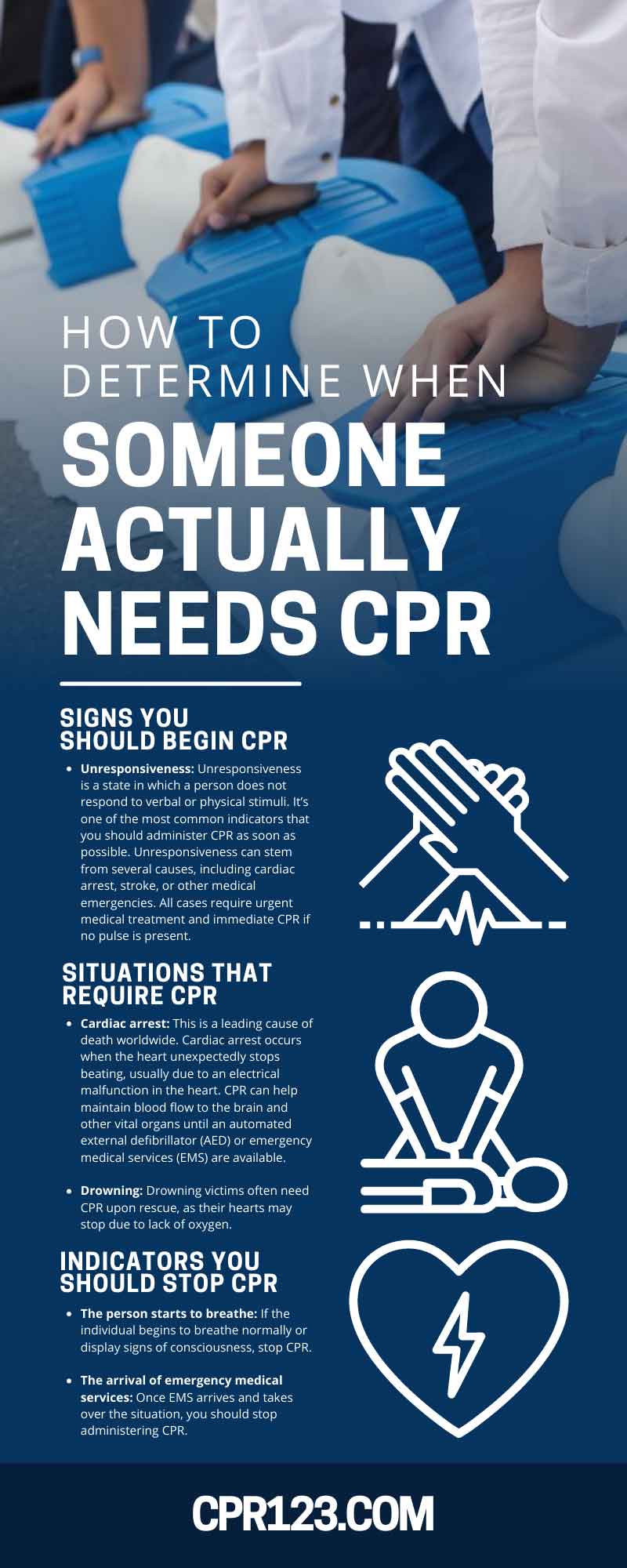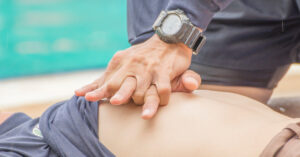Cardiopulmonary resuscitation (CPR) is a technique that can mean the difference between life and death when someone’s heart stops beating or they stop breathing. Knowing when to perform CPR and when to refrain from it is essential to helping in an emergency situation rather than causing more harm. Here, we’ll explore the signs and situations that indicate someone requires CPR, as well as discuss when not to perform CPR at all. This will give you the knowledge necessary to make an informed decision if you find yourself faced with a health and safety emergency. With that, here’s how to determine when someone actually needs CPR.
Signs You Should Begin CPR
Before diving into specific situations that require CPR, it’s important to know the key signs that someone may need it. Understanding these signs allows you to assess the circumstances and most accurately decide whether your intervention might benefit or harm the victim. Call for emergency assistance and start performing CPR if an individual is exhibiting any of these signs:
- Unresponsiveness: Unresponsiveness is a state in which a person does not respond to verbal or physical stimuli. It’s one of the most common indicators that you should administer CPR as soon as possible. Unresponsiveness can stem from several causes, including cardiac arrest, stroke, or other medical emergencies. All cases require urgent medical treatment and immediate CPR if no pulse is present.
- Weak and irregular or no pulse: You should also start CPR if you can’t find a pulse or feel an altered pulse when inspecting a person in distress. To determine if an individual has a pulse, place the first two fingers of your hand on their neck or wrist and press lightly. A normal pulse will feel like a steady beat that is about 60–100 beats per minute in adults. If the person does not have a clear pulse or has a very weak and irregular one, it’s an indicator that CPR is necessary.
- Abnormal or no breathing: Abnormal breathing in an unresponsive individual is another sign that you should initiate CPR. This type of breathing can look like gasping, shallow breaths, or no breaths at all. If a person is unresponsive and not breathing normally, start performing CPR until help arrives or a pulse returns.
- Bluish skin color: If an individual is unresponsive and has bluish skin (ashen or cyanotic), this can be a sign that their blood isn’t getting enough oxygen. When this happens, it’s imperative that you begin CPR as soon as possible to restore oxygenated blood flow. It’s important to note that some individuals may have naturally darker skin tones, which can make it difficult to determine whether they have a bluish hue. In these cases, check for other signs, such as unresponsiveness and abnormal breathing, before choosing a course of action.
Situations That Require CPR
Once you’re aware of the telltale signs you should administer CPR, you can start assessing whether the action is necessary. Still, it helps to know specific situations where CPR is a must. Here are some common scenarios where CPR may be necessary:
- Cardiac arrest: This is a leading cause of death worldwide. Cardiac arrest occurs when the heart unexpectedly stops beating, usually due to an electrical malfunction in the heart. CPR can help maintain blood flow to the brain and other vital organs until an automated external defibrillator (AED) or emergency medical services (EMS) are available.
- Drowning: Drowning victims often need CPR upon rescue, as their hearts may stop due to lack of oxygen.
- Choking: If an individual is choking and becomes unconscious, CPR may help dislodge the obstruction and maintain blood circulation.
- Drug overdose: An overdose often results in respiratory depression, where the person’s breathing becomes dangerously slow or even stops altogether. CPR may help maintain blood flow to the brain in such cases.
- Electrocution: If someone has experienced electrocution, their heart may stop and they might need CPR.
Indicators You Should Stop CPR
While CPR can be a lifesaver, prolonging this activity after it’s no longer necessary can cause additional harm to the patient prior to EMS arrival. Just like you need to know how to determine when someone needs CPR, it’s also essential to know when to stop. Here are some common indicators you should cease performing CPR:
- The person starts to breathe: If the individual begins to breathe normally or display signs of consciousness, stop CPR.
- The arrival of emergency medical services: Once EMS arrives and takes over the situation, you should stop administering CPR.
- The scene becomes unsafe: If your surroundings become hazardous due to fire, a gas leak, an active shooter, or another dangerous scenario, you should prioritize your safety and stop performing CPR.
- Exhaustion: If you’re too physically exhausted to continue, it may be best to discontinue CPR, especially if there’s no one around to help.
- An AED becomes available: If someone brings an AED to the scene, pause CPR to use the defibrillator, following its instructions.
When Not To Perform CPR
Additionally, you should know when to opt out of performing CPR at all. While it’s a useful tool in many situations, there are times when it won’t help the condition of the person in distress. Here are some situations where CPR may not be appropriate or necessary:
- Do Not Resuscitate (DNR) order: If the person has a valid DNR order in place, you should respect their wishes and refrain from performing CPR. Be sure to inform EMS of the DNR order upon their arrival.
- Life-threatening injuries: In cases where the individual suffers massive trauma or life-threatening injuries that are incompatible with life, CPR may not be effective and could potentially cause further harm.
- Unsafe environment: As mentioned earlier, if the scene is unsafe for you to perform CPR, prioritize your safety and avoid administering it.
Understanding when to perform CPR, when to stop, and when not to perform it at all can make a significant difference in emergency situations. By familiarizing yourself with the signs that indicate someone requires CPR, you’ll be better prepared to make informed decisions and potentially save a life. Remember to always call for emergency assistance and use an AED if available. Additionally, consider taking a certified CPR course, like CPR123’s BLS instructor training course, to gain hands-on experience and knowledge. This will ensure you’re well-equipped to not only handle emergencies confidently and effectively, but also to teach others to do the same.








